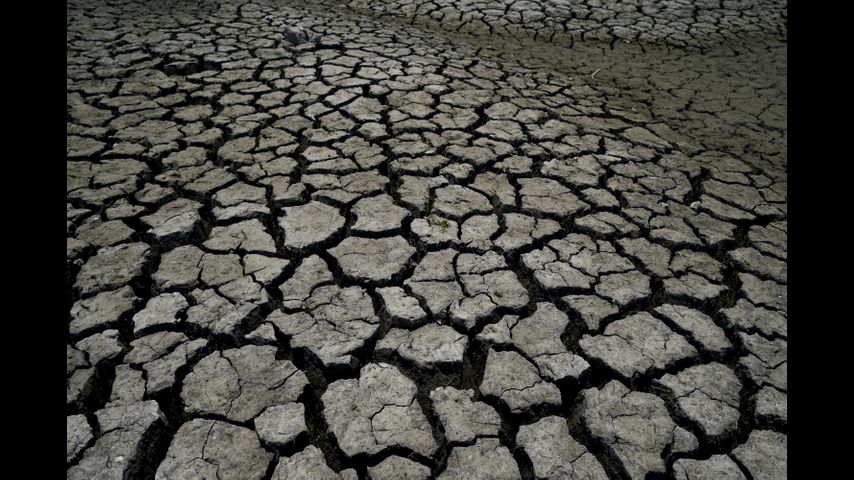Drought in northern Mexico threatening livelihoods
SANTIAGO, Mexico (AP) — Restaurant owner Leticia Rodríguez celebrated the construction late last year of a new lakeside boulevard in this northern Mexico town that she hoped would draw more people to her business. But now with La Boca reservoir nearly empty, tourists have stopped coming to boat, water ski or just eat a meal.
Rodríguez had to let go most of her staff in April and now runs the restaurant with her husband and children.
RELATED: 22 pallets of water donated to Nuevo Leon
A deepening drought in northern Mexico is not only making everyday life challenging for residents, but also in some cases is threatening their livelihoods.
"The only hope is that it rains," Rodríguez said. "That even the tail of a hurricane arrives so that the reservoir can recover, because that is what is killing us the most."
Last week, Mexico's National Water Commission declared a drought emergency allowing the government to take steps to guarantee the water supply. The country's Drought Monitor placed almost half the country -- nearly all of the north and central regions -- in drought conditions.
The drought is related to the weather event known as La Niña, whose effects have intensified with climate change. La Niña is a natural and cyclical cooling of parts of the equatorial Pacific that changes weather patterns worldwide. In some areas like northern Mexico and the U.S. southwest, that has meant increased drought.
The drying up of Santiago's reservoir is not the only problem for the industrial hub of Monterrey, about 22 miles (35 kilometers) to the north.
Another reservoir that feeds the city, Cerro Prieto is at less than half of 1% of its capacity - basically empty - leaving a third reservoir called El Cuchillo, which is 46% full, said Juan Ignacio Barragán, director general of the Monterrey Water and Sewer Services.
In normal conditions, 60% of the city's water comes from the reservoirs and the remainder from deep and shallow wells and subterranean water capturing tunnels.
In the next two weeks, Barragán said the city plans to expand the use of tankers to deliver water to more outlying neighborhoods.
To mitigate the worsening situation, Nuevo Leon state's industrial and agricultural sectors agreed to cede a significant amount of their water rights to the state. Even so, experts say the next few weeks will be critical. If the usual arrival of rains in late August are delayed, water restrictions in the city will have to be extended.
Aldo Iván Ramírez, a professor in Monterrey Technological University's engineering school, said that while Monterrey's situation is worrisome - it accounts for 12% of Mexico's GDP - "it is much worse in other localities of the country."
The city faced serious drought in 1998 and 2013, but it's more complicated now because only El Cuchillo still has water, he said.
This year's water crisis still caught many in the city by surprise. Few homes had tanks to store water. Many people have now adopted measures to conserve water.
"I think this crisis has made the people think a lot," Ramírez said. "I wouldn't want to see a hurricane come and alleviate this crisis and everyone forget about it because that would be the worst thing that could happen to us."
Back in Santiago, Rodríguez, the restaurant owner, said that before it dried up hundreds of tourists came to the reservoir every weekend.
On a recent day, she pointed across the muddy lake bottom to an abandoned restaurant well into the lake where diners used to arrive by boat. It closed earlier this year when the water receded and the tourists stopped coming.
"For me this is worse than the pandemic, because at least in the pandemic there were people," the 54-year-old Santiago native said.
Now ducks walk in the shallow water around the end of the dock where tourists used to board boats for lake cruises.
Sitting on one of the seats of the formerly floating dock, 65-year-old Juan Pérez said he lost his job along with 60 others when the company that gave boat tours went under earlier this year. Now he survives working as a janitor for the town.
"It's sad to see it like this ... it's worse than a cemetery," Pérez said, remembering the festive atmosphere that used to reign on weekends here.
Authorities are trying to get as much of the remaining water out of La Boca as possible.
They installed a floating pump that they hope will extract some 105 gallons (400 liters) of water per second that will be piped to Monterrey, said engineer Raúl Ramírez, whose company installed the pump. They planned to leave enough water to keep alive the remaining aquatic life.
Standing on a dry lake bed that months ago was covered with water, Ramírez said: "We were warned of the possibility that this could occur since last year and unfortunately as a society we didn't listen, we didn't want to understand."





